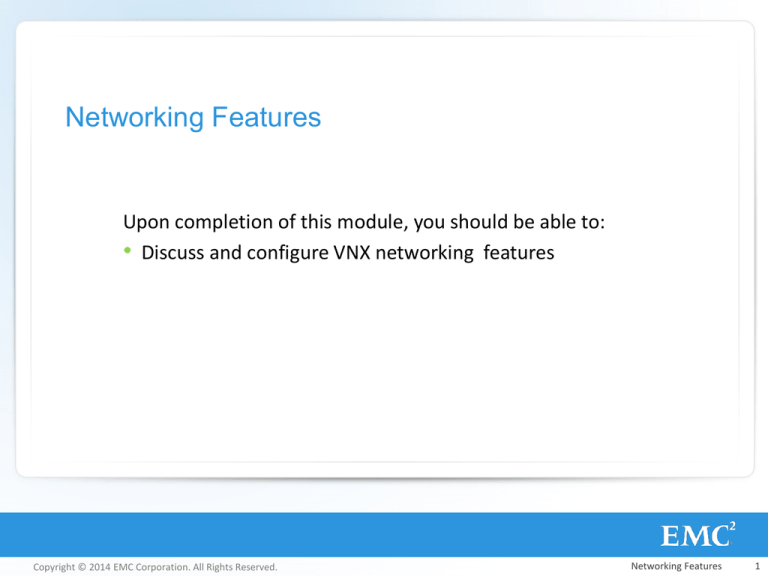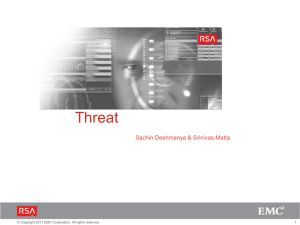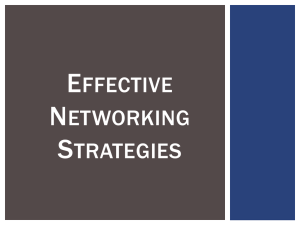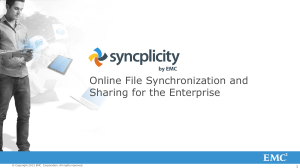
Networking Features
Upon completion of this module, you should be able to:
• Discuss and configure VNX networking features
Copyright © 2014 EMC Corporation. All Rights Reserved.
Networking Features
1
Networking Features
Lesson 1: Networking Features Overview
During this lesson the following topics are covered:
• Basic network concepts and terminology
• VLANs and VLAN tagging
• Roles of networking features
• Types of virtual devices
• Physical, virtual and logical interfaces on a Data Mover
Copyright © 2014 EMC Corporation. All Rights Reserved.
Networking Features
2
Networking Devices Overview
• Ethernet hub (EMC recommends no hubs in VNX environment)
Layer 1
All traffic sent to all ports
Half duplex mode only
• Ethernet switch
Layer 2
Sends traffic to specific port
100Mbps+/Full duplex support
• Managed Ethernet switch
Allow control and traffic management
Includes features such as Ethernet Channel, LACP and VLANs
Can operate at Layer 3
• Infrastructure must support VNX feature
Copyright © 2014 EMC Corporation. All Rights Reserved.
Networking Features
3
Virtual Local Area Network (VLANs)
• Groupings of switch ports
Divides large number of ports
Confines broadcasts
Contributes to security
Can combine physically separate LANs
• A VNX Physical device may be required to participate in multiple
network segments
VLAN Tagging
Copyright © 2014 EMC Corporation. All Rights Reserved.
Networking Features
4
VLANs
• Top diagram illustrates a “public
•
•
•
•
network”
Bottom diagram illustrates three
“private networks”
Physical location is not relevant
to VLAN number
VLAN numbers are defined by
the local administrator
InterVLAN traffic must be routed
Copyright © 2014 EMC Corporation. All Rights Reserved.
Networking Features
5
VLAN Tagging
• A single network interface card can be assigned multiple logical
interfaces
Different VLAN can be assigned to each interface
Destination IP address must match the interface IP address
The packet's VLAN tag must match the interface's VLAN ID
• Zero (or blank) is the default value of VLAN ID
Packets are sent without tags (default value)
• VLAN Tag (ID)
Written by device that transmits the frame
• Switch port settings
Type trunk
Protocol setting 802.1Q
Copyright © 2014 EMC Corporation. All Rights Reserved.
Networking Features
6
VLAN Tagging (continued)
• Protocol 802.1Q
• Individual Ethernet
•
•
switch port is classified
as a trunk port
Administrator must
allow specific VLANs to
use the trunk port
VLAN tagging is seen in
many enterprise
networking
environments
Copyright © 2014 EMC Corporation. All Rights Reserved.
Networking Features
7
Roles of Networking Features
• High Availability:
Ethernet Channel
Link aggregation
Fail-Safe Network
• Increase Network Flexibility:
VLAN Tagging
Copyright © 2014 EMC Corporation. All Rights Reserved.
Networking Features
8
Virtual Device Overview and Usage
• Virtual device is a combination of multiple physical devices
•
defined by a single MAC address.
You cannot individually assign same IP address to different
physical devices on a Data Mover
Duplicate IP
Different MAC addresses
• Virtual devices are used to distribute data among multiple
physical ports in case of failure
Copyright © 2014 EMC Corporation. All Rights Reserved.
Networking Features
9
Types of VNX Virtual Devices
• Ethernet Channel
Dependent on pre-existing Ethernet configuration (customer must
provide)
• Link Aggregation
Dependent on pre-existing Ethernet configuration (customer must
provide)
• Fail Safe Network
Independent of pre-existing Ethernet configuration
Should be configured across two Ethernet switches
Copyright © 2014 EMC Corporation. All Rights Reserved.
Networking Features
10
Ethernet Channel and LACP
• Ethernet Channel
Static configuration
No support for Port Aggregation Protocol (PAgP)
Works with Cisco EtherChannel
• Link Aggregation (LACP)
Industry standard (802.3ad) alternative to EtherChannel
• Both provide more overall bandwidth than a single port
Connection to any single client runs through one physical port, and
is therefore limited by the port’s bandwidth
• When the connection to one port fails, the switch automatically
switches traffic to the remaining ports
Copyright © 2014 EMC Corporation. All Rights Reserved.
Networking Features
11
Ethernet Channel and LACP Comparison
Feature
Ethernet Channel
Link Aggregation
Switch Support
Switch must use IEEE standard,
Fast or Gig Ethernet
Switch must support IEEE 802.3ad
Link Aggregation
Link Speeds
Allows links of different speeds
Disables links with a different speed
than the majority
Duplex
Number of Ports
Full or half
Full
2, 4, or 8
2 - 12
Availability
Broken links are physically marked
as “up” on the Data Mover, but the
switch will detect the down link and
redirect traffic to the Data Mover
down other links
Better link control: LACPDU frames
are transmitted on each link in the
aggregation to ensure they are not
broken
Misconfiguratio
n Protection
Misconfigured links difficult to
detect
Detects misconfigured links and
marks them as down
Copyright © 2014 EMC Corporation. All Rights Reserved.
Networking Features
12
VNX Use of Statistical Load Distribution
• Applies for Ethernet Channels and Link Aggregation devices
• Three methods of statistical load distribution
MAC address
IP address (default)
IP address and TCP port
• Port Failure
Traffic redirect to live port
• Incoming and outgoing traffic ports may differ
Copyright © 2014 EMC Corporation. All Rights Reserved.
Networking Features
13
Fail Safe Network
• Extends link failover by providing switch-level redundancy
• A FSN appears as a single link with a single MAC address, and
•
•
•
potentially multiple IP addresses
A FSN is comprised of a physical port, Ethernet Channel, Link
Aggregation or any combination of the three
Only one connection in a FSN is active at a time
There is no requirement that the connections making up a FSN
be the same type, or that the connections be made to the same
network switch
Copyright © 2014 EMC Corporation. All Rights Reserved.
Networking Features
14
Cross-Stack EtherChannel
Cross-Stack Switches
Stack A
Switch 1
Switch 2
Switch 3
Copyright © 2014 EMC Corporation. All Rights Reserved.
Cross-Stack
EtherChannel
Networking Features
15
Networking Features
Lesson 1: Summary
During this lesson the following topics were covered:
• Basic network concepts and terminology
• VLANs and VLAN tagging
• Roles of networking features
• Types of virtual devices
• Physical, virtual and logical interfaces on a Data Mover
Copyright © 2014 EMC Corporation. All Rights Reserved.
Networking Features
16
Networking Features
Lesson 2: Networking Features Configuration
During this lesson the following topics are covered:
• Creating an Ethernet Channel device
• Creating a LACP device
• Creating a FSN device
• Creating VLAN IDs on an interface
Copyright © 2014 EMC Corporation. All Rights Reserved.
Networking Features
17
VNX Network Terminology Review
• Physical Device (device name)
The actual ports on the Data Mover (e.g., cge-1-0, fge-2-3)
Not a variable
• Virtual Device (device name)
User assigned variable name
Combination of multiple physical devices
• Logical Interface (interface name)
User/System assigned variable name
Assigned an IP address
Copyright © 2014 EMC Corporation. All Rights Reserved.
Networking Features
18
Physical Device (device name)
• The physical port on a Data Mover
cge = Copper Gigabit Ethernet
fge = Optical Gigabit Ethernet
fxg = Optical 10 Gigabit Ethernet
• Not a variable
• Can support multiple interfaces/IP
addresses with VLAN Tagging
• 10/100/1000 Mbps or 10 Gbps
• Half/Full/Auto
Copyright © 2014 EMC Corporation. All Rights Reserved.
Networking Features
19
Physical - Logical (device – interface)
• No virtual devices in this
•
•
configuration
An interface name is created
and an IP address is assigned
using a physical copper
Gigabit Ethernet port on a
primary Data Mover
Other IP addresses can be
created on the same physical
interface
Interface name must differ
VLAN Tagging may be required
Copyright © 2014 EMC Corporation. All Rights Reserved.
Networking Features
20
Physical - Virtual - Logical
• Two physical devices (cge-1-
•
•
0 and cge-1-1) are used to
create a virtual device lacp0
using the LACP Protocol
An IP address is assigned
using the virtual device lacp0
Other IP address can be
created on the same virtual
interface
interface name must differ
VLAN Tagging
Copyright © 2014 EMC Corporation. All Rights Reserved.
Networking Features
21
Creating a Virtual Device
• Cannot use physical devices that
have previously been used
Settings > Network > Settings for File >
Devices > Create
They will not be displayed
• Standby Data Mover(s) will
inherit configuration
Ethernet switch should be setup
in advance (required for Ethernet
Channel and Link Aggregation)
• Primary Variables
Data Mover
Type
Ethernet Channel
Link Aggregation
Fail Safe Network
Device Name
User must configure
Copyright © 2014 EMC Corporation. All Rights Reserved.
Networking Features
21
Creating an Ethernet Channel Virtual Device
• Settings > Network > Settings
•
•
•
•
•
for File > Devices (tab) >
Create
Select Data Mover
Select Ethernet Channel
Enter Device Name
Select Ports
Select Speed/Duplex
Should be set to match
Ethernet switch settings
From Device tab
Copyright © 2014 EMC Corporation. All Rights Reserved.
Networking Features
22
Creating a Link Aggregation Virtual Device
• Settings > Network > Settings
•
•
•
•
•
for File > Devices (tab) >
Create
Select Data Mover
Select Link Aggregation
Enter Device Name
Select ports
Select Speed/Duplex
Should be set to match
Ethernet switch settings
Note: cge-1-0 and cge-1-1 are not
listed because they are already in
use
Copyright © 2014 EMC Corporation. All Rights Reserved.
From Device tab
Networking Features
24
Creating a FSN Virtual Device
• Settings > Network > Settings
•
•
•
•
for File > Devices (tab) > Create
Select Data Mover
Select Fail Safe Network
Enter Device Name
Select Devices
Primary (optional)
Standby
• Can combine
Dissimilar Ethernet devices
Virtual and physical devices
From Device tab
Copyright © 2014 EMC Corporation. All Rights Reserved.
Networking Features
25
FSN Role of Primary and Standby
• Primary should be used if
members are not equal
The primary is a better data
path
More reliable
Faster
Optional
• Standby
Will support failed link
Will not fail back when primary
failure is corrected
From Device tab
Copyright © 2014 EMC Corporation. All Rights Reserved.
Networking Features
26
Creating a Data Mover Interface
• IP address are assigned to Virtual
devices same as Physical devices
• Physical devices used by Virtual
devices will not be selectable
• Auto calculating Broadcast Address
• Default optional values
Name: The IP address with the
value “-” replacing “.”
10.0.0.1 would be 10-0-0-1
MTU: 1500
VLAN ID: 0
Copyright © 2014 EMC Corporation. All Rights Reserved.
Networking Features
27
Managing Virtual Devices
• Settings > Network > Settings for
•
File > Devices
Right-click on device and select
properties for more detail
Adjust speed and duplex
Copyright © 2014 EMC Corporation. All Rights Reserved.
Networking Features
28
Deleting Virtual Devices
• Settings → Network →
Settings for File → Devices
Select item for removal; right
click > select delete, or click
on delete button
• Can only delete one virtual
device at a time
• Cannot delete devices that
have dependencies
In use by CIFS server
In use by another virtual device
Virtual devices must be deleted in
the reverse order from how they
were created
Copyright © 2014 EMC Corporation. All Rights Reserved.
Networking Features
29
Networking Features
Lesson 2: Summary
During this lesson the following topics were covered:
• Creating an Ethernet Channel device
• Creating a LACP device
• Creating a FSN device
• Creating VLAN IDs on an interface
Copyright © 2014 EMC Corporation. All Rights Reserved.
Networking Features
30
Networking Features
Lesson 3: Complex Examples and Considerations
During this lesson the following topics are covered:
• Network features to support a complex environment
• VNX and Ethernet switch requirements
• Active data paths in case of failure
• Networking high availability considerations
Copyright © 2014 EMC Corporation. All Rights Reserved.
Networking Features
31
VNX Configuration
• Two physical devices (cge-1-0 and
cge-1-1) are used to create a virtual
device “lacp0” on a Data Mover
• Two physical devices (cge-1-2 and
cge-1-3) are used to create another
virtual device “lacp1” on a Data
Mover
• Both Virtual devices (lacp0,lacp1)
are used to create another Virtual
device “fsn0”
• An IP address is assigned using the
virtual device fsn0
Copyright © 2014 EMC Corporation. All Rights Reserved.
lacp1
fsn0
lacp0
10.127.57.233
Networking Features
32
Optional: Creating Multiple Logical Interfaces
• If connection to a single network
segment is not enough, use VLAN
Tagging
• IP addresses are on different
network segments (different VLANs)
• VLAN value provided by Ethernet
switch administrator
• Set VLAN ID to match Ethernet
switch value
Example: If fsn0 uses all ports and
customer needs to connect to
multiple network segments, VLAN
Tagging should be used
Copyright © 2014 EMC Corporation. All Rights Reserved.
Networking Features
33
Ethernet Switch Configuration
lacp0=cge-1-0,cge-1-1 (primary)
fsn0 lacp1=cge-1-2,cge-1-3 (secondary)
Switch
Switch
Network
Copyright © 2014 EMC Corporation. All Rights Reserved.
Networking Features
34
Example: Active Data Path
Phase 1: Normal Operation
Virtual
Device
Status
Device
cge-10
cge-11
cge-12
cge-13
lacp1
Device
Active
cge-10
Active
cge-11
Standb
y
cge-12
Standb
y
cge-13
lacp0
fsn0
Phase 3: Port failures
Virtual
Device
Status
Off-line
cge-10
Off-line
cge-11
Active
cge-12
Active
cge-13
lacp0
fsn0
lacp1
Phase 2: Port failure
Virtual
Device
Status
Device
Phase 4: Port failures
Virtual
Device
Status
Device
cge-10
Off-line
cge-10
Active
cge-11
Standb
y
cge-12
Standb
y
cge-13
cge-11
cge-12
cge-13
lacp0
fsn0
lacp1
Copyright © 2014 EMC Corporation. All Rights Reserved.
Phase 5: Failure resolved (no primary)
Virtual
Device
Status
Device
cge-10
Off-line
cge-11
Off-line
cge-12
Active
cge-13
fsn0
lacp1
lacp0
fsn0
Standb
y
Active
lacp1
Active
Phase 5: Failure resolved (primary=lacp0)
Virtual
Device
Status
Device
Off-line
lacp0
Standb
y
Active
lacp0
Active
fsn0
lacp1
Standb
y
Standb
y
Networking Features
35
Speed and Duplex Considerations
• VNX speed and duplex setting must match Ethernet switch
• Failure to address has negative results
Failure to connect
Performance problems
• Creation of an Ethernet Channel or Link Aggregation device
requires user to set speed and duplex (default = 1000 FD)
• An FSN device inherits speed and duplex currently configured on
member devices
See Basic Network Configuration module for more information
Copyright © 2014 EMC Corporation. All Rights Reserved.
Networking Features
36
Data Mover Failover Network Considerations
• Failed network connections do not trigger Data Mover failover
Data Mover is operating normally, network is not
• Standby Data Mover requires identical configuration
Any Ethernet Channels or Link Aggregation devices require same
configuration on Ethernet switch
Any trunk ports used with VLAN tagging require same
configuration on Ethernet switch
• Test configuration when deploying configuration
Incorrect configuration for standby Data Mover could cause service
interruption in failover situation
Copyright © 2014 EMC Corporation. All Rights Reserved.
Networking Features
37
Confirming the Ethernet Switch
• Confirm channels have been created (if required)
Cisco EtherChannel
LACP
Typical for EMC personnel not to have access to Ethernet Switch
devices
Dependency on customer to provide information
• Confirm trunk ports have been created (if required)
• Commands used to create channels are issued on the VNX AND
Ethernet Switch
Copyright © 2014 EMC Corporation. All Rights Reserved.
Networking Features
38
LACP Considerations
• A LACP link can be created with any number of physical devices
• Only Full Duplex Ethernet ports can be used to create the link
If a mixture of port speeds is given, the Data Mover will choose the
greatest number of ports at the same speed
In case of a tie, the fastest ports are chosen
• Although multiple links are joined, no one client will gain an
advantage from this configuration with regards to network speed
or throughput
Link determined by source/destination IP address
Can also load balance based on source/destination MAC address
or source/destination IP address AND source/destination TCP/UDP
ports
Copyright © 2014 EMC Corporation. All Rights Reserved.
Networking Features
39
Networking Features
Lesson 3: Summary
During this lesson the following topics were covered:
• Network features to support a complex environment
• VNX and Ethernet switch requirements
• Active data paths in case of failure
• Networking high availability considerations
Copyright © 2014 EMC Corporation. All Rights Reserved.
Networking Features
40
Summary
Key points covered in this module:
• Virtual network devices extend fault tolerance into the network
by providing port redundancy
• FSN protects against switch failures
• High Availability solution need to include aligned switch port
configurations for Primary and Standby Data Movers
Copyright © 2014 EMC Corporation. All Rights Reserved.
Networking Features
41








